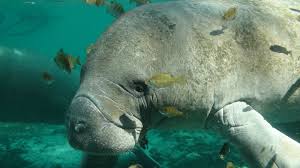Is the Antillean Manatee Population Dangerously Low?
The Antillean manatee along with the Florida manatee are sub-species of the West Indian Manatee
Greetings! It is no surprise when I tell you here all three of the planet’s manatee species are threatened and are in real danger of going extinct. Namely, the Amazonian Manatee, the African Manatee, and the West Indian Manatee with its subspecies of the Florida Manatee and the Antillean Manatee. In January 2017, the Florida Manatee count was hovering just north of 6,200, which is good. However, a major outbreak of red tide, as was evident in 2013 killed 829 Florida manatees!
The African Manatee, also called the West African Manatee is very difficult to research. As a result, there is very little information on both the extent and distribution range of this marine mammal. Thus, scientists use their information on habitat range of the Florida manatee population and have been able to report “there may be fewer than 10,000 manatees in West Africa.” The most sobering news of diminishing populations of manatees has to do with the Antillean manatee. According to the Red List of Threatened Species, “there are less than 2,500 mature Antillean Manatees in the world, mostly in Mexico and Belize.” The latest news report from the August 17th 2017 issue of ScienceDaily says, “Smithsonian scientists were first to use sonar to estimate Antillean Manatee populations in the murky waters of Panama’s internationally protected San San Pond Sak wetlands.”
Hector M. Guzman, marine biologist at the Smithsonian Tropical Research Institute [STRI] who was the main lead in the Antillean population study said, “The most thorough of its kind, our study offers reliable, sonar-based estimates of manatee numbers vital to the survival of this vulnerable species. Mother/calf pairs are commonly observed upstream – outside the protected area. We communicated that to the authorities nearly three years ago and recommended modifications to the limits of the reserve along rivers. Every year there are at least two manatee deaths, mostly calves or young ones. Our population estimates in indicate that even though the population seems constant, it won’t recover if young manatees continue to be killed by the use of illegal fishing nets.”
The Red List estimated during 2008, there were approximately just 10 to 20 Antillean Manatees in Panama. And scientists explained, “Without effective conservation actions, 20 percent of these great creatures are expected to disappear in the next 40 years.”
Law has protected the Antillean Manatees living in Panama since 1967. And the largest population is thought to be found in Panama’s province of Bocas Del Toro. The waters in Panama where the Antillean manatee lives are quite murky. This makes it rather difficult to get an accurate count there as compared to the clear waters of Florida, where counts from the air work best.
In Panama, Hector Guzman and Richard Condit, staff scientist emeritus at STRI wanted to experiment with a new sonar method for detecting the manatees in the cloudy water.
Guzman used his sonar to cut through the murky water and observed about “1250 miles of river with side-scan sonar during a one-year period. That is nearly 100 repeated sweeps of the 12 miles of protected river in the mangrove and forest-lined San San estuary.” The result? Guzman and Condit estimate there were “2 to 33 individuals” living in the water at San San Pond Sak. The scientists stated, “We hypothesize that the regional population could be considerably higher than our estimates.” Here’s the issue…
In 2004, an Antillean manatee plan was drafted. It looked at “land-tenure conflicts, sources of pollution and a co-management strategy for protection of manatees in the area.” Guzman explained, “However, 20 years after the creation of the protected area, we have not seen any of those recommendations go into effect.” He continued and said, “Ironically, the endangered status of this species was reiterated last December within the Ministry of the Environment’s Resolution DM-0657-2016, but there is still a lack of effective local policy to protect manatees – authorities are not paying attention to the human activities going on in these river systems. People are using fishing nets, which are illegal within this wetland designated as ‘internationally important’ under the international RAMSAR convention.”
As more news on this becomes available, I’ll be sure to let you know!
If you are in Florida and you see a sick or injured manatee, please call the Florida Fish and Wildlife Conservation Commission at: 1-888-404-FWCC. They are the folks who are responsible for rescuing us in Florida.
Here’s the Save the Manatee Club link to learn more about us manatees …
Here’s a cool link for you to learn more about how we’re rescued and brought into rehabilitation …
~ Kobee Manatee
Related Posts
Manatee Trivia (Part 1)! March 29, 2017
Manatee Trivia (Part 3)! April 21, 2017
